Is English Ivy Toxic to Cats, Dogs and People?
The English ivy (Hedera helix) is a popular flowering plant with lush green foliage and the ability to climb up and cling to walls, fences, and trees with its aerial roots. Plant lovers grow it for its lush, attractive, and often variegated foliage, which easily greens up interior and exterior spaces, and adds an aesthetic touch to design schemes and outdoor recreational areas. Furthermore, as an indoor plant, English ivy is renowned for its air-purifying properties, which remove pollutants and counteract mold growth indoors, thereby improving air quality.
Still, despite the numerous benefits of English Ivy, if you share your home with pets, this beauty may pose some risks to your beloved furry companions. So, if you’re wondering how safe it is to care for an English ivy in a home with pets, you’ve come to the right place. This article will help you understand the risks associated with this beautiful evergreen vine and learn how to keep it out of reach from small children and four-legged members of your family.
Let’s dive in and learn about the English ivy’s toxicity to cats, dogs, and people.
Is English Ivy Poisonous?
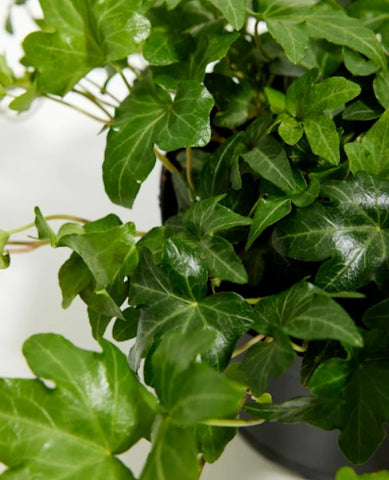
Yes, the English ivy is poisonous. It contains toxins that can cause skin irritation, vomiting, allergic reactions, and more. These symptoms can affect people and animals alike if they touch the plant or consume a small part of it by accident. The main culprits behind the harmful effects are toxic triterpenoid saponins and poly-acetylene compounds. Additionally, contact with the common ivy’s sap can cause dermatitis.
Another toxic ivy variety is the Poison ivy (Toxicodendron radicans) and its close relative the Poison oak (Toxicodendron diversilobum), which contains a harmful oil substance, called urushiol.
Is English Ivy Toxic to Cats?
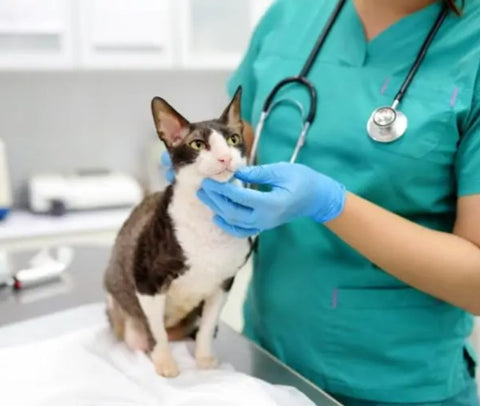
Unfortunately, the English ivy is toxic to cats and other felines. It contains poisonous compounds known as polyacetylene and hederagenin (a type of saponin). The plant’s foliage is more dangerous than the berries if consumed even in a small quantity.
Also, it’s important to know that your kitty doesn’t actually need to nibble on the plant’s leaves to feel unwell. It’s a well-known fact that cats are instinctively wary of tasting strange or unfamiliar things.
Most commonly, feline pets suffer from the adverse effects of a toxic plant when they rub against its leaves, flowers, or stems. Then, during grooming sessions, the cat inadvertently ingests the poisonous substance by licking its fur.
What Happens If a Cat Eats English Ivy?
If you suspect that your cat has chewed on parts of your English ivy plant, it may show some disconcerting symptoms of feeling sick. See below some of the signs to watch out for:
- Vomiting
- Excessive salivation
- Drooling
- Swelling of the mouth, tongue, and lips
- Diarrhea
- Breathing difficulties
- Irregular heartbeat
- Fever
- Frequent urination
- Itching or scratching
- Red, watery eyes
- Difficulty swallowing
To point out, you may not notice some or any of these sure signs of English ivy poisoning in your cat. But if you see that it feels subdued and unwell, always inspect your ivy for traces of contact to confirm whether your cat has chewed on the plant. This will help your veterinarian decide on the best course of action, as eating parts of the plant can be potentially more harmful than ingesting a small amount of the toxin during your cat’s grooming routine.
What Do I Do If My Cat Eats English Ivy?
If you’re certain that your cat has eaten some of the English ivy plant, you should see your veterinarian or visit a nearby pet poison control center immediately. In this case, you shouldn’t even wait for your cat to show any signs or symptoms, as they may take time to appear. Also, it would be a good idea to bring a sample of the plant with you and show it to the pet-care specialist.
Since antidotes for toxic plants like English ivy are rare, the veterinarian may offer supportive therapy for your cat, including intravenous fluid therapy or anti-nausea medications.
How to Make English Ivy Safe for Cats?
There are many ways to make your English ivy safe for cats. Firstly, you can plant same cat grass in a container that your kitty has an easy access to. This will deter your feline from trying other indoor plants that you grow at home.
It's also a good idea to keep your ivy out of your cat’s reach if possible. With that said, cats are great climbers and jumpers, so consider placing your plant in a room where your kitty is simply not allowed.
Last but not least, since cats are quite reactive to smells, a pet deterrent spray can also be considered. Apply some to the plant’s pot, and your mischievous cat won’t dare to go near it due to the unpleasant smell.
Is English Ivy Toxic to Dogs?
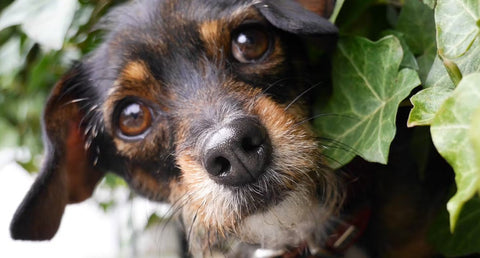
The English ivy is also toxic to dogs. The same naturally occurring chemicals (saponins and polyacetylene compounds) in the plant can trigger a wide range of side effects in dogs, as well. The difference here is that dogs are more likely to actually nibble on the ivy and ingest the toxin than cats, and thus suffer more severely from the consequences.
What Happens If a Dog Eats English Ivy?
Look for these signs and symptoms if your dog eats some parts of your English ivy:
- Nausea
- Excessive drooling
- Abdominal pain
- Diarrhea
- Skin reactions like blistering, redness, and swelling
- Loss of appetite
- Vomiting
- Skin irritation
What Should I Do If My Dog Eats English Ivy?
If you believe that your dog has consumed part of the English ivy plant, the first step is to rinse its mouth thoroughly with water to remove as much of the toxins as possible. Wash your canine’s fur if it has also come in contact with the plant’s sap.
In any case, it’s best to be on the safe side and take your dog for a checkup at your local veterinarian clinic. Again, don’t wait for symptoms of discomfort and distress to show before you act. Also, don’t try any home remedies or give any non-prescribed medication to your furry friend, as it may worsen its condition.
How Do I Get My Dog to Stop Eating Ivy?
The best way to get your dog to stop eating ivy is the right mix of positive and negative reinforcement training. Furthermore, relocating your English ivy somewhere high will also help you keep your dog safe. Unlike cats, dogs will rarely attempt to jump out of curiosity or boredom to snack on a toxic plant.
Is English Ivy Poisonous to Humans?
Yes, English ivy is poisonous to humans, due to containing harmful compounds like hederagenin glycosides, saponins, and terpenoid saponins. These can cause some mild or more serious side effects, such as skin irritation, breathing problems, and more.
Is English Ivy Poisonous to Touch?
The English ivy plant is poisonous to touch. Its sap can trigger allergic contact dermatitis - a very uncomfortable rash. Swelling and shortness of breath are two other common symptoms of coming in contact with this ornamental plant, especially if the person is sensitive, or prone to allergies.
Is English Ivy Safe for Babies?
No, English ivy isn’t safe for babies and small children. Touching the plant can cause airborne contact dermatitis, which is an allergic skin rash. In addition, if your curious toddler decides to taste the leaves of English ivy, this could potentially cause nausea, vomiting, and diarrhea, among other side effects.
To keep young children safe around the plant, watch them closely to prevent ingestion or contact with it. Moreover, you should explain to your kids about the risks and teach them not to touch unfamiliar plants without adult supervision.
English Ivy: Safety Tips
To prevent any health issues, related to accidental English ivy poisoning, create a pet- and child-safe indoor and outdoor environment. Also, consider these safety tips:
- When repotting, pruning, or cleaning your English ivy, wear gloves and long sleeves to protect your hands and arms from the toxic sap.
- It’s advisable to grow the plant in a hanging basket or place its planter at a suitable height. This will help you keep it out of reach from pets and young children.
- If you have an English ivy outdoors, be careful while trimming it to contain the plant's size. Never rip away the branches but cut them at the base instead.
- Never burn European ivy. Its toxins and irritants can make the air hazardous to inhale.
Pet-safe Plant Alternatives to English Ivy
If you're looking for safe alternatives to English ivy (Hedera helix) that are pet-friendly, consider growing the following plants:
1. Boston Fern
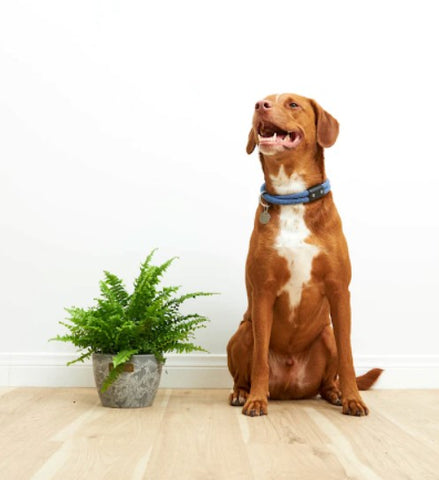
The Boston fern (Nephrolepis exaltata) is non-toxic to pets, so your cat or dog will be safe around the plant. With its lush foliage, this tropical plant can be a great addition to your indoor garden. As it enjoys humidity, your bathroom can be an ideal place for a Boston fern.
2. Spider Plant

Another pet-safe beauty is the Spider plant (Chlorophytum comosum), also known as the Spider ivy. It’s a beginner-friendly and easy-care plant, which is famous for its air-filtering properties, just like the English ivy. The Spider plant’s arching light-green fronds won’t harm your curious and playful pet, that’s for sure.
3. Neanthe Bella Palm
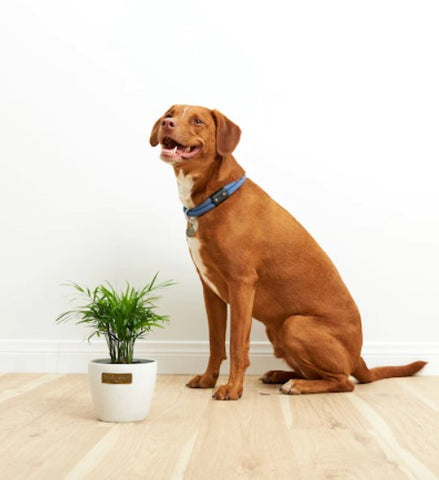
The Neanthe Bella palm (Chamaedorea elegans) can add an exotic vibe to any home that welcomes pets. This plant is considered non-toxic to cats and dogs, like many other indoor palm varieties. It’s resilient, low-maintenance and can adapt to a range of growing conditions. The Neanthe Bella palm is quite compact, so it can be easily placed on a tabletop or a shelf.
Is English Ivy Toxic to Cats, Dogs, and People? FAQs
Q: What type of ivy is safe for cats?
A: Swedish ivy (Plectranthus verticillatus), also called Creeping Charlie, is safe for cats. It’s a beautiful green cascading plant with lovely round, softly serrated leaves and small bluish-purple flowers. Other pet-friendly ivy-like varieties include Grape ivy (Cissus rhombifolia), Kenilworth ivy (Cymbalaria muralis), and Ivy Peperomia (Peperomia griseoargentea).
Q: Is English ivy and poison ivy the same thing?
A: No, English ivy and poison ivy aren't the same thing. Both these plants belong to different plant families and differ in their toxicity levels.
Q: Is English ivy bad for allergies?
A: Yes, English ivy can be bad for allergy sufferers. If you’re sensitive to pollen or plant allergens, it can potentially aggravate your allergy or trigger a serious reaction.
Q: Is English ivy bad for your house?
A: The English ivy plant can cause damage to your property’s structure if your house is old and not well-maintained. The aerial roots of the plant can cling to compromised walls or wooden frames and fences, and thus, weaken further their integrity.
Conclusion
Awareness of English ivy’s toxicity to pets and humans is vital to fostering a safe indoor and outdoor environment. If you’ve got cats, dogs, or small children at home, you should take appropriate measures to prevent incidental poisoning from ivy plants. The best thing to do is to keep the plant out of reach from young kids and pets.
You can also opt for and grow various non-toxic alternatives, such as an indoor olive tree, Chinese money plant, or any of the already mentioned pet-safe plants. This way, you can ensure that you and your furry friends are protected against any potential harm from exposure to an English ivy plant.












Leave a comment